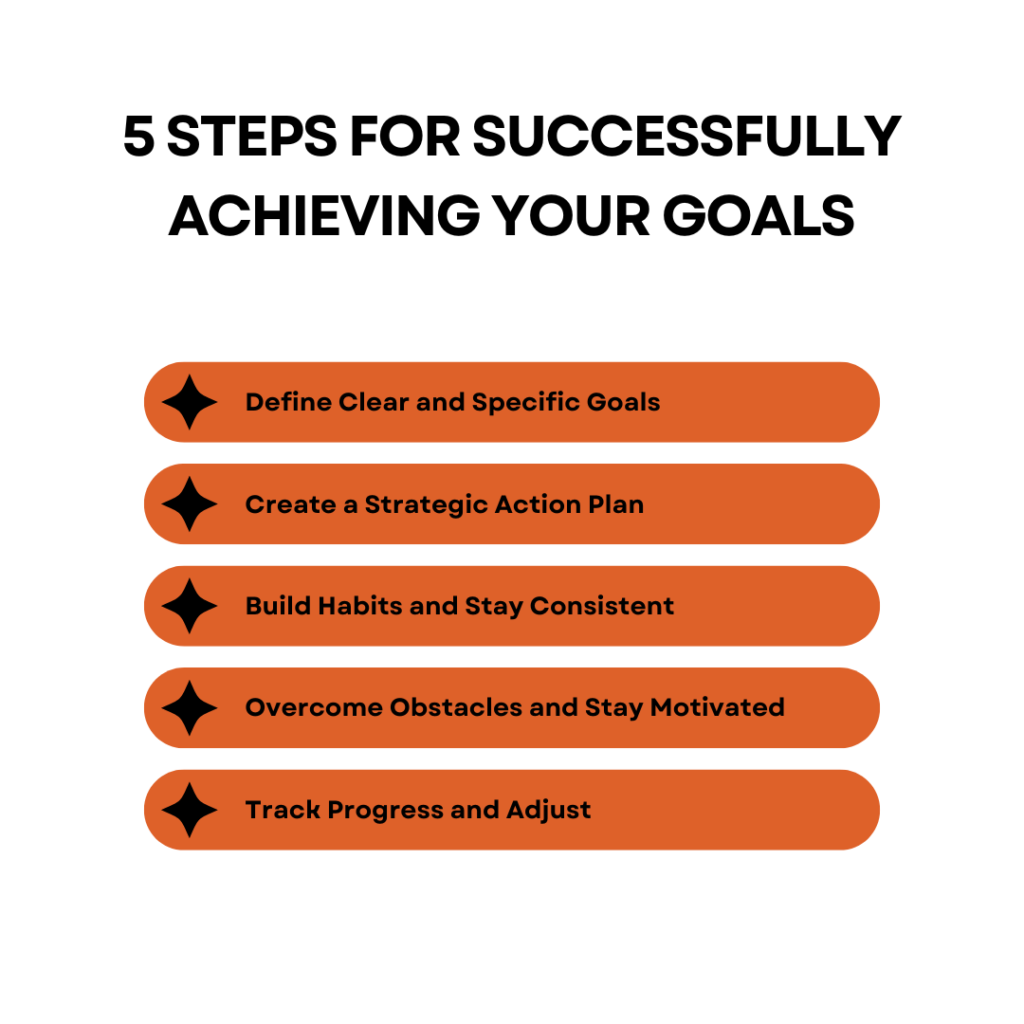
The Ultimate Guide: 5 Steps for Successfully Achieving Your Goals
Introduction
5 Steps for Successfully Achieving Your Goals. If you’ve ever set a goal but struggled to reach it, you’re not alone. Research from the University of Scranton suggests that only 8% of people actually accomplish their New Year’s resolutions. The key to success isn’t just setting goals—it’s about having a clear strategy and executing it properly.
Goal-setting is essential for success in business, personal development, and fitness. Studies show that writing down goals increases the likelihood of achieving them by 42%. Experts like Dr. Edwin Locke, who developed goal-setting theory, argue that well-defined objectives significantly boost motivation and performance.
However, achieving your goals requires more than just wishful thinking. It involves defining goals clearly, creating a plan, staying consistent, overcoming obstacles, and tracking progress. This guide breaks down the 5 essential steps for achieving your goals, all backed by psychology, real-life examples, and expert insights.
Read also : The Shocking Truth: What Are 5 Negative Effects of Social Media?
Get your free E-book
Over 50 Tips and Tricks to Radically Change Your Life in 6 Months
Step 1: Define Clear and Specific Goals

The Power of SMART Goals
A goal without clarity is just a wish. To turn ambitions into actionable objectives, use the SMART framework:
- Specific: Define exactly what you want to achieve.
- Measurable: Establish criteria to track progress.
- Achievable: Set realistic targets.
- Relevant: Align with your broader life objectives.
- Time-bound: Set a deadline.
Real-World Example
Let’s say you want to “get fit.” That’s vague. A SMART version would be: “Lose 10 pounds in 3 months by exercising 4 times a week and following a calorie-controlled diet.”
Insights from Psychology and Neuroscience
Dr. Edwin Locke’s goal-setting theory suggests that challenging yet attainable goals boost motivation. Neuroscience also supports this: setting clear targets activates the brain’s dopamine system, reinforcing positive habits. Studies also show that visualizing your success can enhance motivation and increase your chances of success by improving focus and resilience.
Additionally, goal clarity helps in reducing cognitive overload. When we are unsure about what we want to achieve, we tend to feel overwhelmed and procrastinate. Having well-defined goals eliminates uncertainty and fosters action. This principle is evident in athletic training, business strategies, and educational success.
Furthermore, Dr. Gail Matthews’ study at the Dominican University found that people who write down their goals and create action plans are significantly more likely to succeed than those who don’t. Clarity, therefore, is not just about knowing what you want—it’s about setting up a structured plan to achieve it.
Read also : Creativity vs. Productivity
Step 2: Create a Strategic Action Plan

Why Planning Matters
A dream without a plan is just a wish. Breaking your goal into smaller steps prevents overwhelm and procrastination.
Effective Planning Techniques
- Backward Planning: Start with the end goal and work backward.
- Time-Blocking: Allocate dedicated slots in your schedule.
- Eisenhower Matrix: Prioritize urgent vs. important tasks.
- Milestone Setting: Break down large goals into achievable milestones.
- Gantt Charts & To-Do Lists: Utilize visual tools to stay on track.
Expert Advice
Business strategist Brian Tracy emphasizes the “6P Rule”: Proper Prior Planning Prevents Poor Performance. This principle applies whether you’re launching a business, writing a book, or preparing for a marathon. Planning creates a roadmap, reducing uncertainty and boosting confidence.
Many successful individuals, from Olympic athletes to Fortune 500 CEOs, attribute their achievements to meticulous planning and strategic execution. As productivity expert David Allen suggests in Getting Things Done, breaking tasks into actionable steps makes them less daunting and easier to complete.
By developing an action plan, you create a sense of urgency and commitment that helps overcome inertia. Additionally, planning ahead allows for better resource allocation, ensuring that you have the tools and support necessary to execute your goals efficiently.
Read also : How Does Mental Health Affect Physical Health?
Get your free E-book
Over 50 Tips and Tricks to Radically Change Your Life in 6 Months
Step 3: Build Habits and Stay Consistent

The Science of Habit Formation
James Clear, author of Atomic Habits, explains that consistency beats intensity. Success isn’t about dramatic changes but small, repeatable actions. Neuroscience confirms that habits are formed through cue-routine-reward loops, making it essential to develop systems that encourage positive behaviors.
Strategies to Stay on Track
- Habit Stacking: Attach new habits to existing routines (e.g., stretching after brushing your teeth).
- The 2-Minute Rule: Start with tiny actions (e.g., read one page instead of “read for an hour”).
- Accountability Partners: Share goals with someone who will keep you responsible.
- Environmental Design: Modify your surroundings to make good habits easier and bad habits harder.
- Daily Habit Tracking: Use a journal or app to reinforce consistency.
Examples of Consistency in Success
- Warren Buffett reads daily to compound his knowledge, reinforcing the habit of lifelong learning.
- Serena Williams practices relentlessly, ensuring steady improvement and mastery of her craft.
- Elon Musk dedicates significant time to deep work, allowing him to innovate and lead multiple companies successfully.
Building habits creates a compound effect, where small, repeated actions lead to exponential progress over time.
Read also : Productivity vs Efficiency – What’s the Difference?
Step 4: Overcome Obstacles and Stay Motivated

Common Challenges
- Procrastination: Caused by fear or lack of clarity.
- Self-Doubt: Negative self-talk reduces confidence and slows progress.
- Burnout: Overworking without rest leads to exhaustion and disengagement.
- External Distractions: Social media, negative influences, and unexpected events can derail progress.
Motivation Theories and Solutions
- Intrinsic vs. Extrinsic Motivation: Focus on internal rewards (personal growth, fulfillment) rather than external validation (money, status).
- Self-Determination Theory: Autonomy, competence, and relatedness drive long-term motivation.
- The Goldilocks Principle: Goals should be challenging but not too difficult to maintain engagement.
Practical Solutions
- Accountability Groups: Join mastermind groups or online communities to stay encouraged and focused.
- Mental Reframing: Shift from “I have to” to “I get to” to foster a positive mindset.
- Celebrate Small Wins: Recognize progress to sustain motivation.
- Develop Resilience: View failures as learning opportunities rather than roadblocks.
Read also : Why Stress Is Good
Step 5: Track Progress and Adjust

Measuring Success
- Key Performance Indicators (KPIs): Set measurable benchmarks for tracking progress.
- Progress Journals: Document milestones, setbacks, and lessons learned.
- Feedback Loops: Adjust based on results and external feedback.
- Reflection and Self-Assessment: Regularly analyze what’s working and what needs improvement.
Read also : Mental Health Is Not a Joke
Get your free E-book
Over 50 Tips and Tricks to Radically Change Your Life in 6 Months
Conclusion
Achieving your goals isn’t about luck—it’s about strategy and discipline. With a clear plan, consistent habits, and resilience, success is within reach. Start today—your future self will thank you!
If you want to go further, here’s a guide. To get it, click here!




